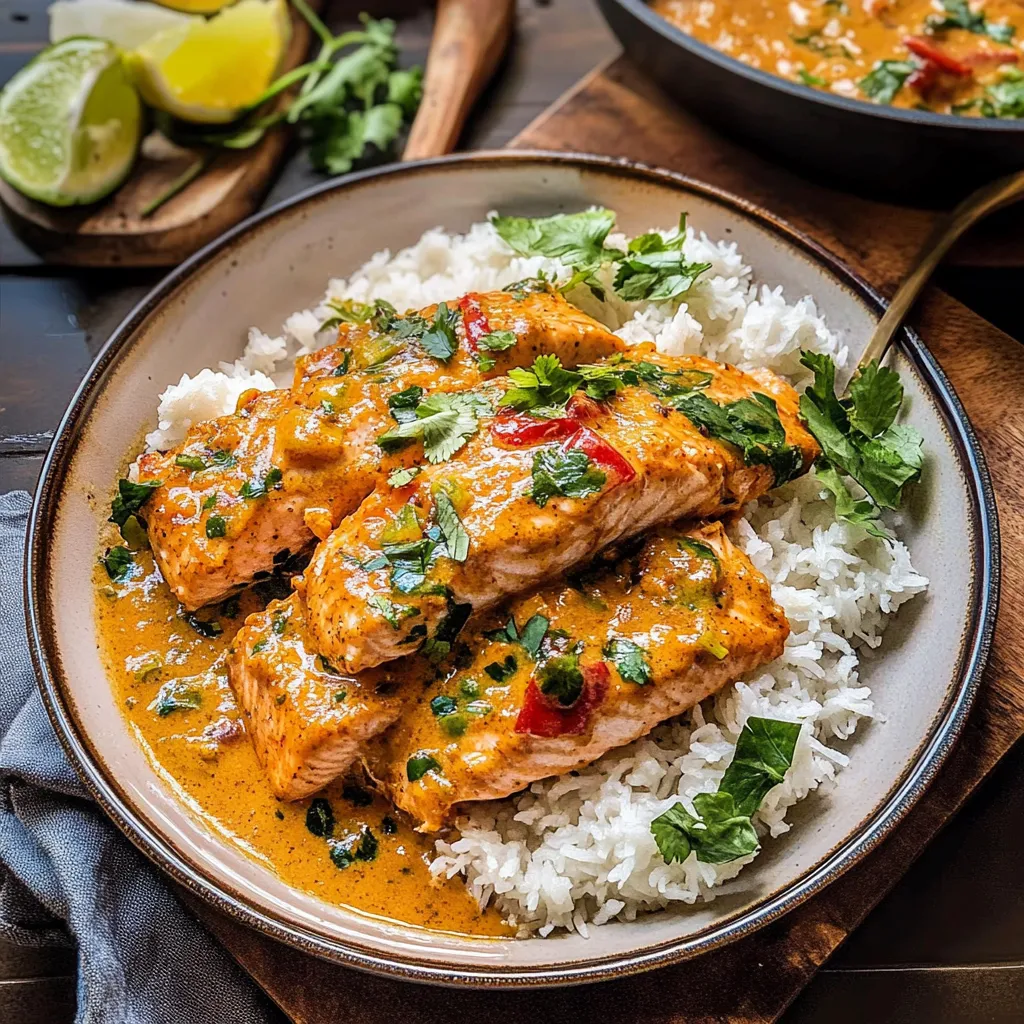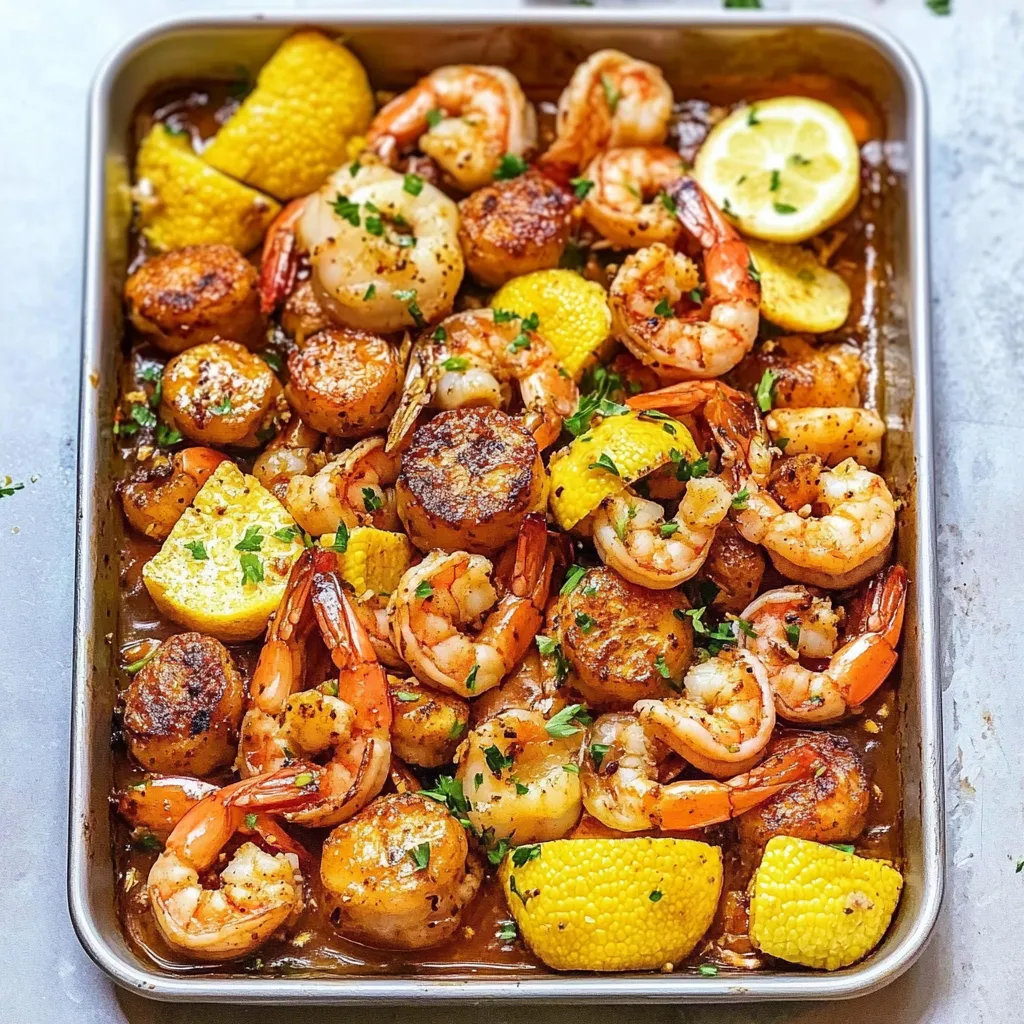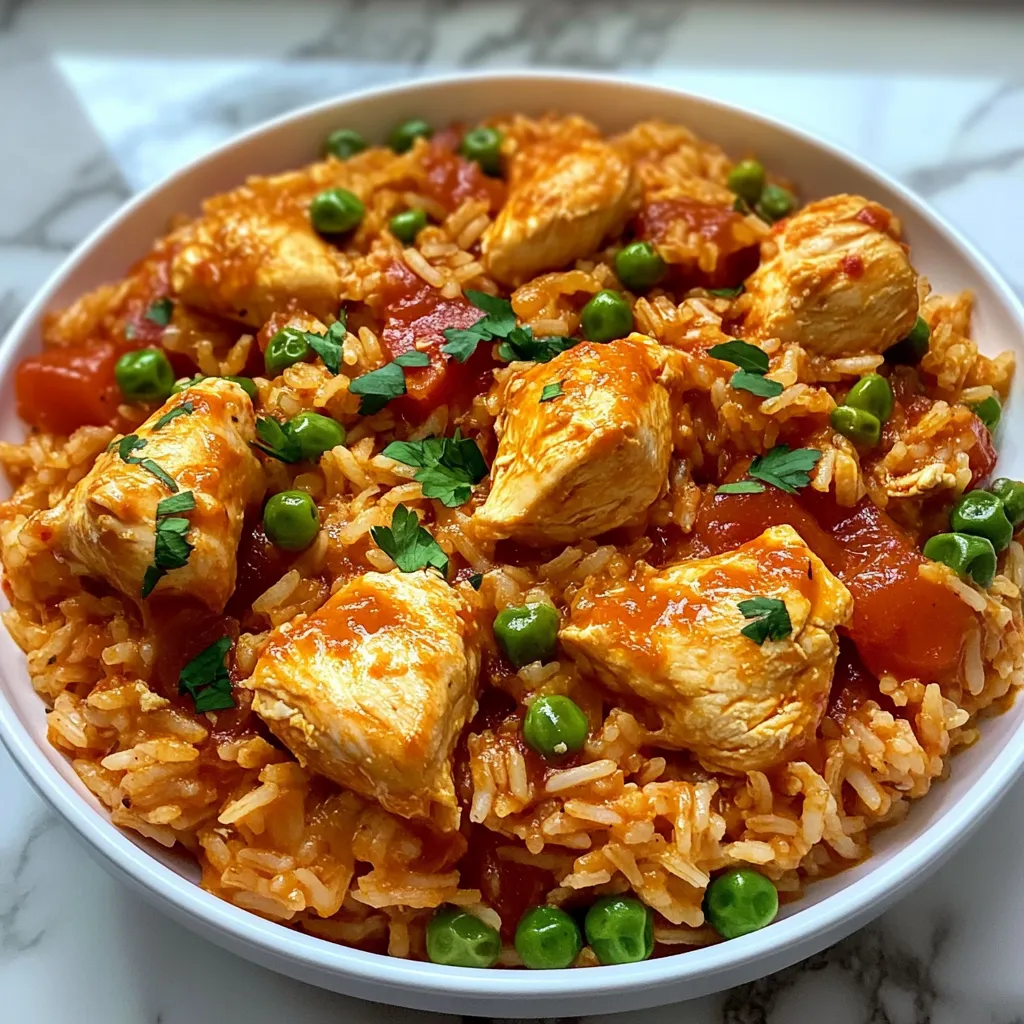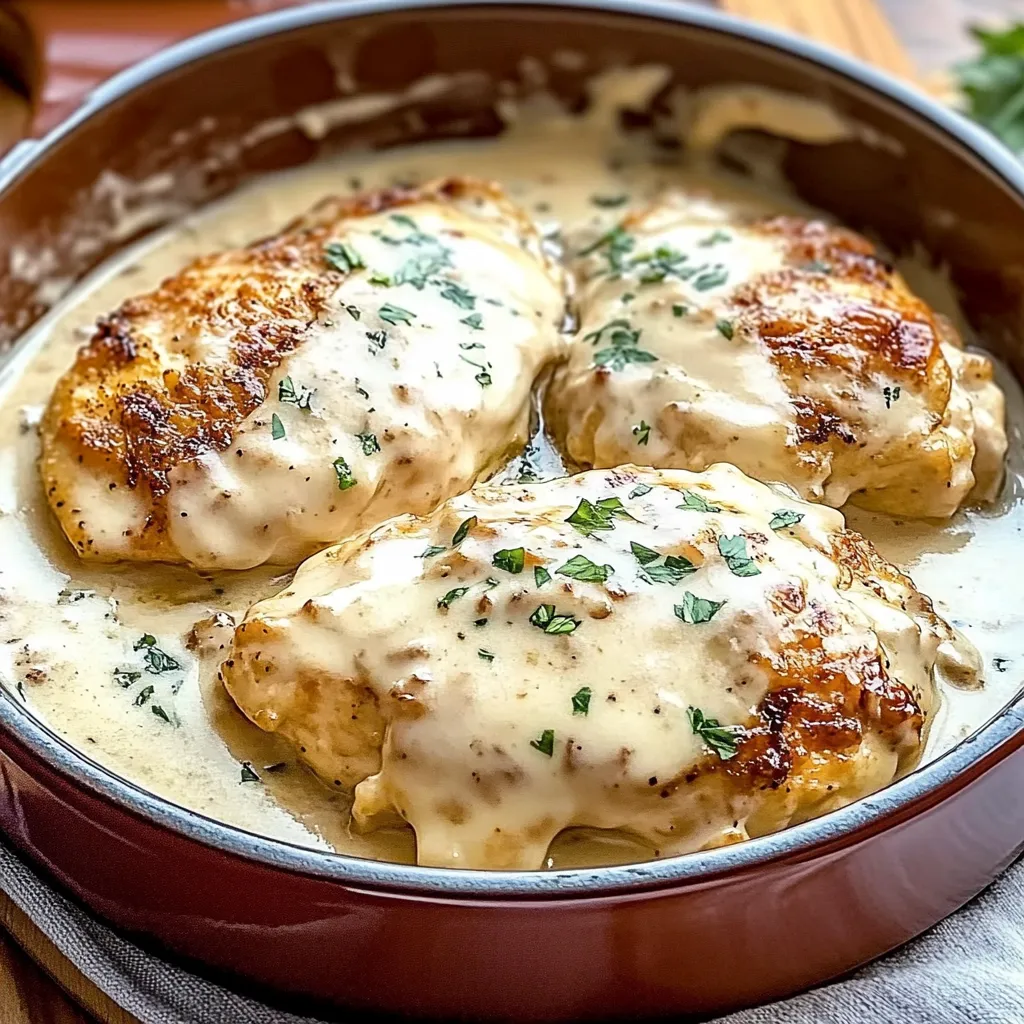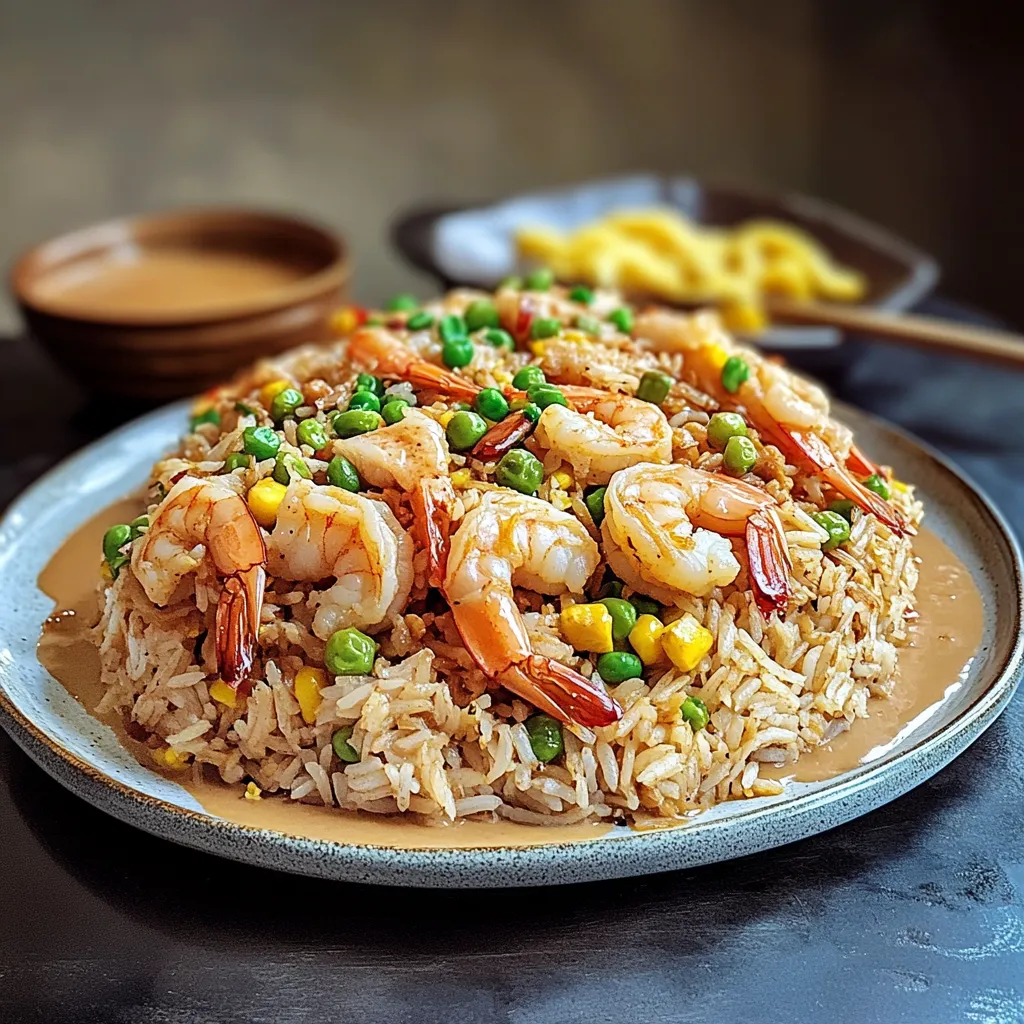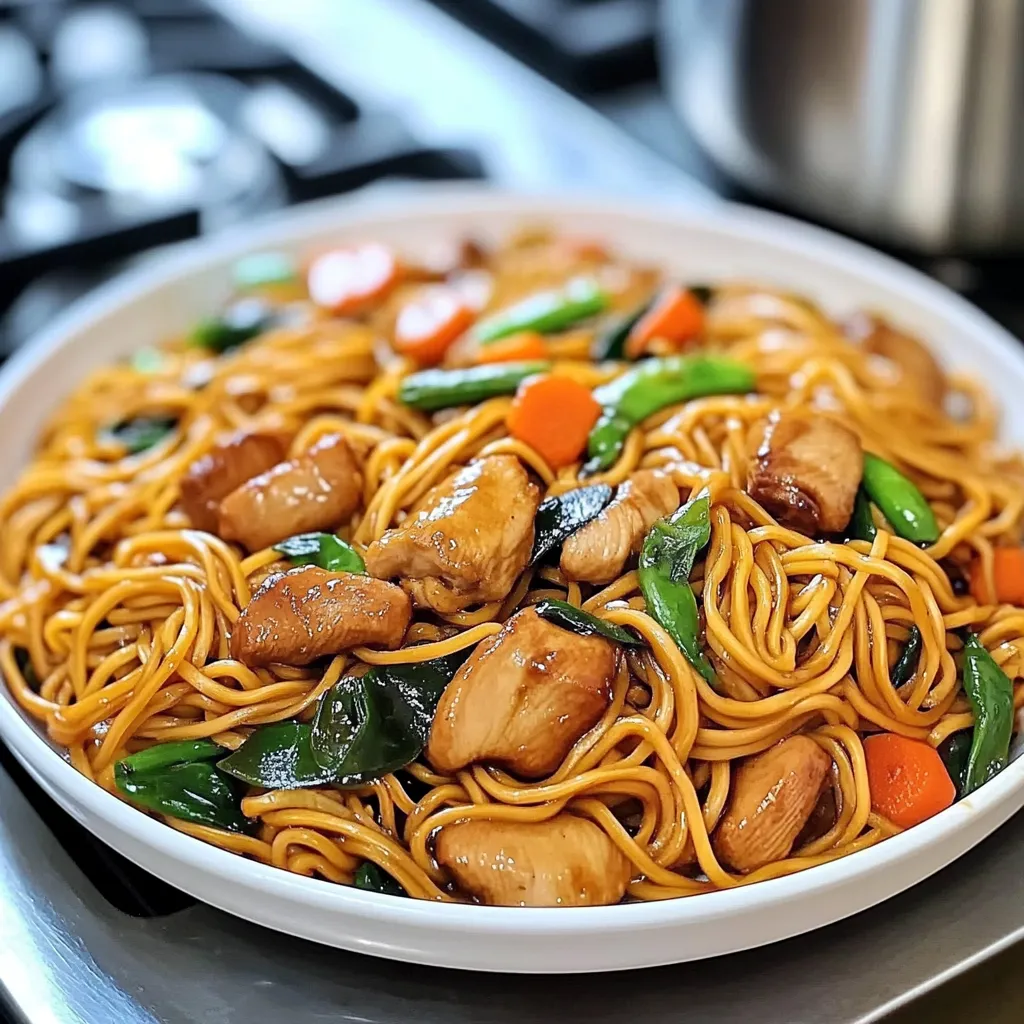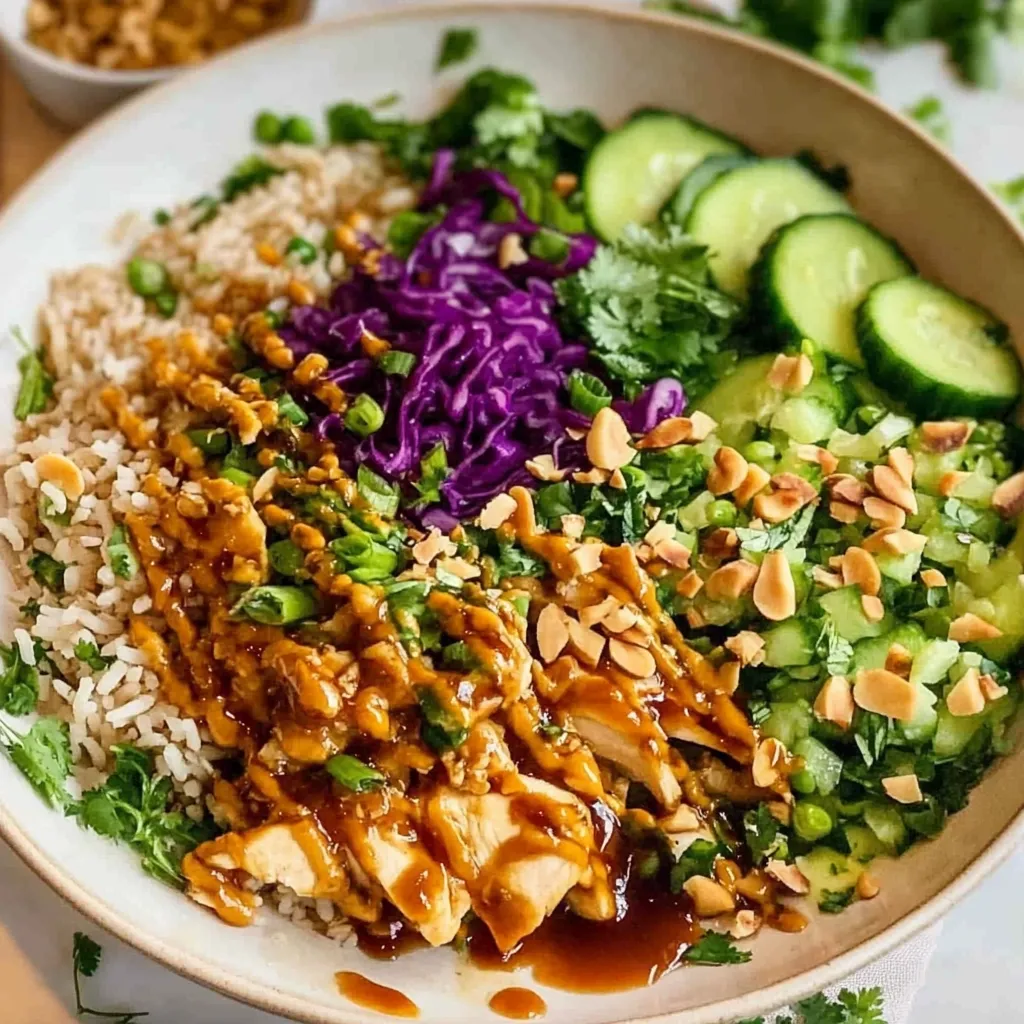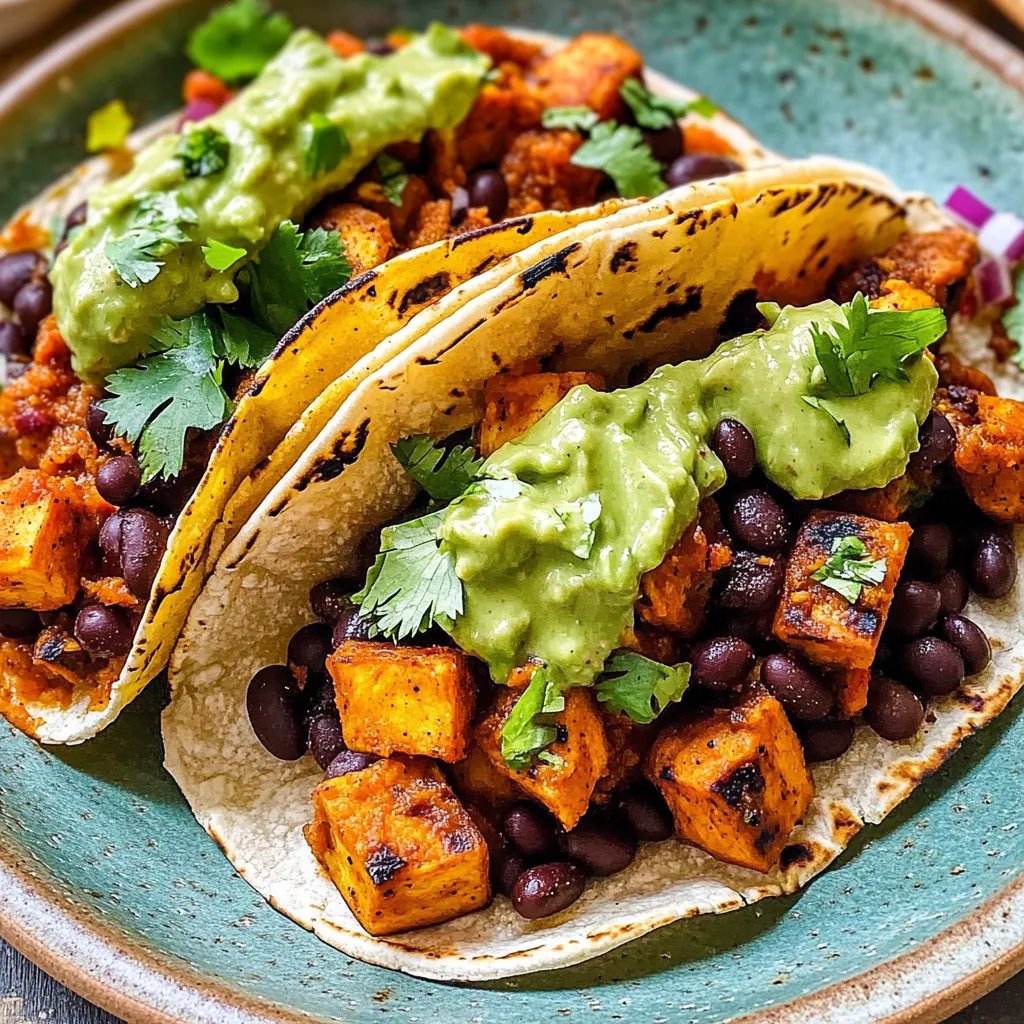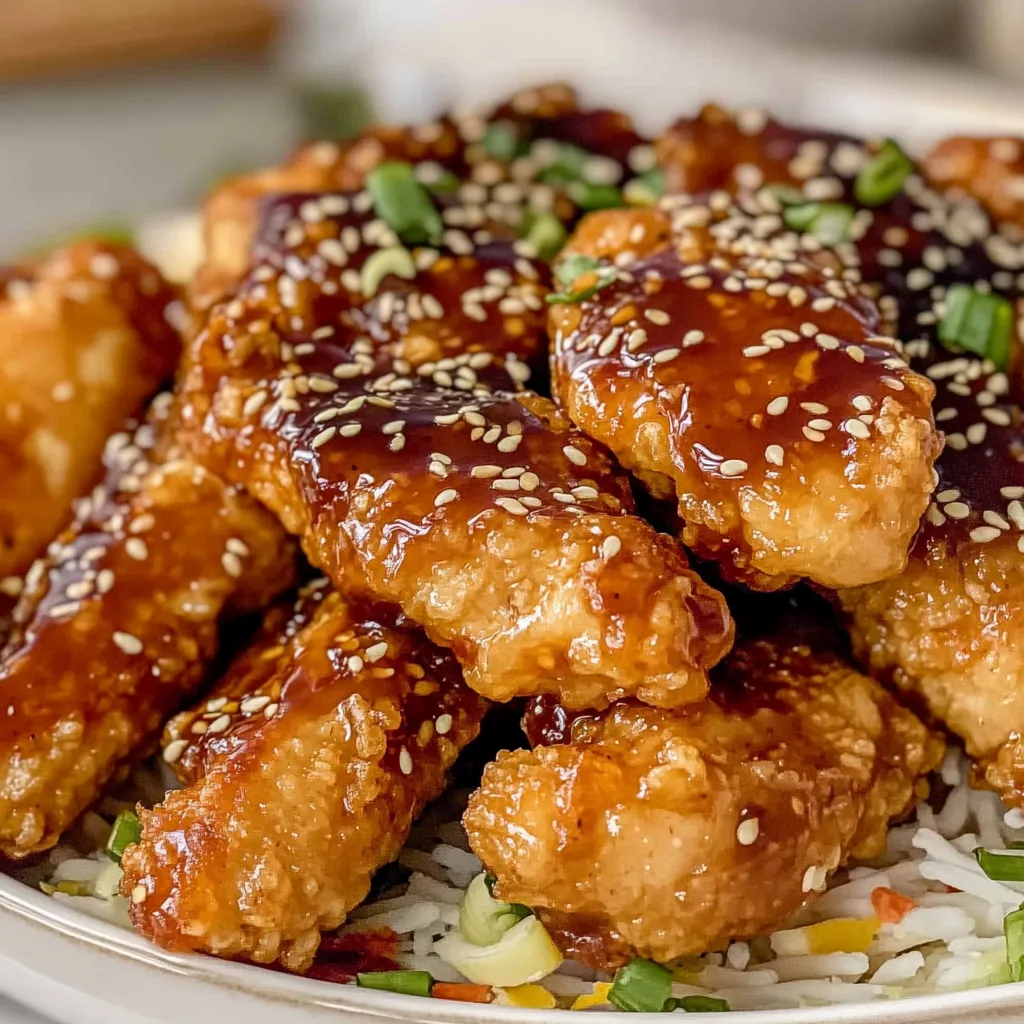If you’re searching for a dish that combines rich flavors with simplicity, look no further than Baked Coconut Curry Salmon. This delightful fusion of creamy coconut milk and aromatic spices not only tantalizes your taste buds but also offers a nutritious meal option. It’s perfect for both weeknight dinners and special occasions, ensuring that every bite is a celebration of culinary bliss.
What makes this recipe so enticing is its versatility. Feel free to experiment with various vegetables like bell peppers or spinach, or swap out salmon for other fish or tofu for a plant-based alternative. For those who crave a touch of heat, adding a pinch of chili flakes or a dash of sriracha can elevate the flavor profile significantly.
Achieving the perfect cook on your salmon is a breeze with our expert tips. Remember to keep an eye on baking time and check the internal temperature for moist, tender results. Dive into this culinary adventure and impress your family or guests with a dish that’s both flavorful and satisfying!
Ingredients for Baked Coconut Curry Salmon:
This delicious and aromatic dish features salmon fillets baked in a creamy coconut curry sauce, perfect for serving a crowd of 8-10 people. Here’s what you’ll need:
For the Salmon:
- 3 pounds of salmon fillets (skin-on or skin-off, depending on your preference)
- 2 tablespoons olive oil or coconut oil for greasing
- 1 tablespoon sea salt
- 1 teaspoon black pepper
For the Coconut Curry Sauce:
- 2 tablespoons coconut oil or vegetable oil
- 1 large onion, finely chopped
- 4 cloves garlic, minced
- 2 tablespoons fresh ginger, grated
- 2 tablespoons red curry paste or to taste (you may substitute with yellow curry paste for a milder flavor)
- 1 can (14 ounces) full-fat coconut milk
- 1 cup low-sodium chicken broth or vegetable broth
- 1 tablespoon fish sauce (optional for added depth)
- 1 tablespoon lime juice (freshly squeezed for the best flavor)
Enhancements for Flavor:
- 1 tablespoon brown sugar or maple syrup for sweetness (adjust according to taste)
- 1 red bell pepper, thinly sliced for added color and crunch
- 1 cup snap peas or green beans for freshness (optional)
- Fresh cilantro or parsley for garnishing
Serving Suggestions:
- 4 cups cooked rice (jasmine or basmati work wonderfully)
- Chili flakes or sliced fresh chilis for those who love heat
- Lime wedges for serving, to squeeze over the salmon just before eating
Feel free to get creative! You can substitute the salmon with another firm fish like mahi-mahi or even shrimp for a seafood twist. Additionally, for a vegetarian version, consider using hearty vegetables like eggplant or tofu instead of fish. Use these ingredients to adapt the dish to your preferences!
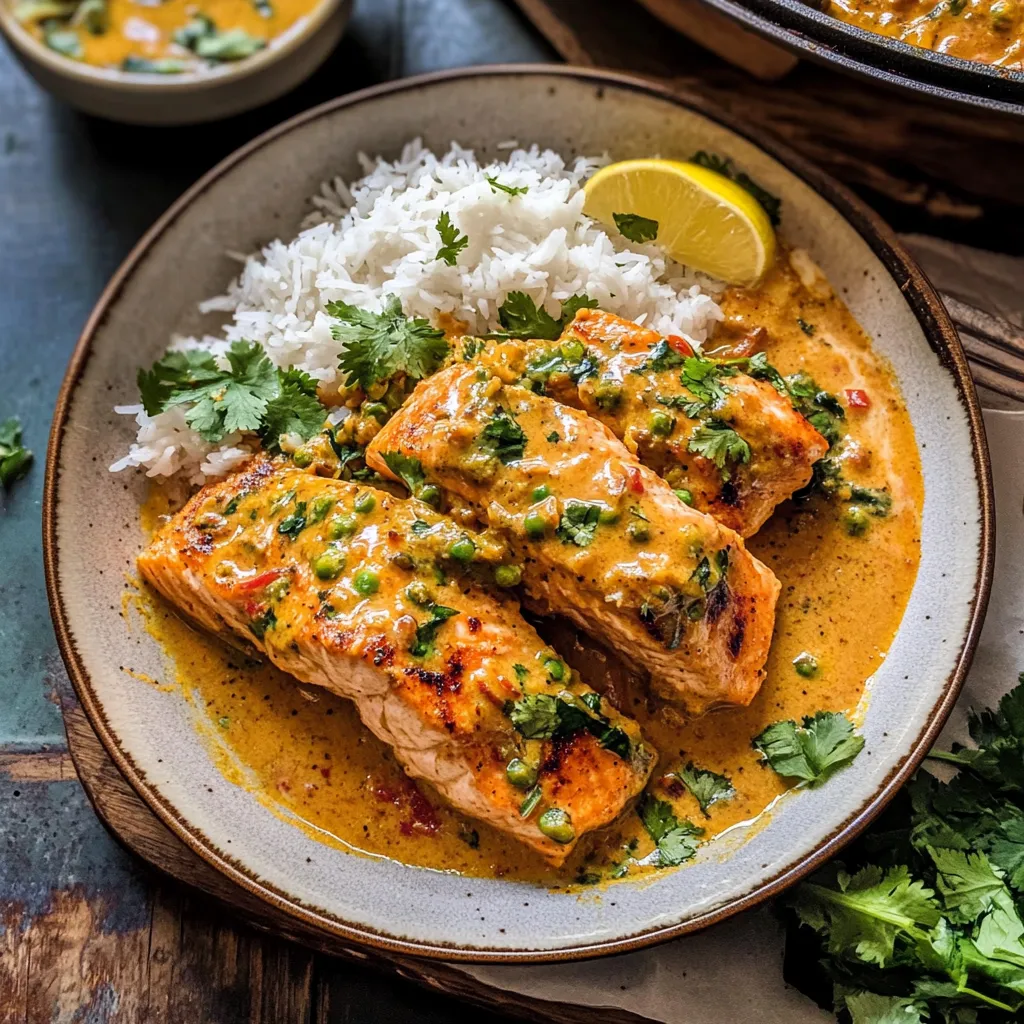
How to prepare Baked Coconut Curry Salmon:
Follow these clear steps to create a delicious Baked Coconut Curry Salmon that combines rich flavors with simplicity.
Step 1: Preheat Your Oven
Begin by preheating your oven to 375°F (190°C). This ensures even cooking and helps develop the flavors in your dish.
Step 2: Prepare the Salmon Fillets
Take four salmon fillets and place them skin-side down on a parchment-lined baking sheet. Ensure they are evenly spaced for proper heat circulation.
Step 3: Season the Salmon
Sprinkle the salmon fillets with salt and black pepper to taste. This simple seasoning enhances the salmon’s natural flavor before adding the curry mixture.
Step 4: Make the Coconut Curry Sauce
In a medium bowl, combine one can of full-fat coconut milk, two tablespoons of red curry paste, and the juice of one lime. Whisk these ingredients together until smooth.
Step 5: Add Flavor Boosters
Stir in minced garlic (two cloves) and grated ginger (one tablespoon) into the coconut mixture. These ingredients will add an aromatic layer to your sauce.
Step 6: Pour the Sauce Over Salmon
Gently pour the coconut curry sauce over the seasoned salmon fillets. Ensure that each fillet is well-coated for maximum flavor absorption.
Step 7: Add Vegetables for Extra Nutrition
Optionally, add sliced bell peppers, zucchini, or snap peas around the salmon on the baking sheet. This step boosts the nutrition of your meal and adds color.
Step 8: Bake the Salmon
Place the baking sheet in the preheated oven. Bake for 15-20 minutes, or until the salmon is cooked through and flakes easily with a fork.
Step 9: Garnish and Serve
Once baked, remove the dish from the oven. Garnish with chopped fresh cilantro and additional lime wedges before serving. This elevates the dish and adds a zesty finish.
Enjoy your vibrant and flavorful meal! Baked Coconut Curry Salmon pairs beautifully with rice or quinoa to soak up the rich sauce.
Tips for the Perfect Baked Coconut Curry Salmon
Maintain the Right Temperature
To achieve consistently tender and flaky salmon, start by preheating your oven to 375°F (190°C). This temperature allows the fish to cook evenly without drying it out. If you have a food thermometer, aim for an internal temperature of 145°F (63°C) for perfectly cooked salmon. Keep an eye on your fish to prevent overcooking; it can go from perfectly done to dry in a matter of minutes.
Use Quality Ingredients
The quality of your ingredients significantly impacts the final flavor of the dish. Choose fresh, wild-caught salmon when possible for the best taste and texture. Opt for high-quality coconut milk, preferably full-fat, to ensure your sauce is rich and creamy. Fresh herbs, like cilantro or parsley, elevate the dish further. If you can, use fresh spices instead of pre-ground ones; they offer a potent flavor that dried spices struggle to match.
Explore Suitable Substitutions
If you follow specific dietary restrictions, don’t worry; you can still enjoy this dish! For a dairy-free option, ensure that your coconut cream or coconut milk is free from additives. If you need a lower-fat alternative, try light coconut milk or yogurt for a creamy base without the added calories.
For a vegetarian version, substitute salmon with firm tofu or chickpeas. Just adjust the cooking time accordingly; while tofu may bake in the same timeframe, chickpeas need a longer cooking period to connect with the curry flavors.
Experiment with Flavor Variations
Feel free to customize the spice blend according to your taste preferences. Add a pinch of cayenne pepper for some heat or a tablespoon of sugar to balance the flavors. You can also incorporate other vegetables like bell peppers or spinach into the coconut curry sauce for added nutrition and a pop of color.
If you want a citrus twist, squeeze some fresh lime juice over the salmon just before serving. This brightens the dish beautifully. Lastly, don’t forget to garnish with toasted coconut flakes or chopped nuts for a crunchy texture contrast.
By following these tips, not only will you create a delicious meal, but you will also impress your family and friends with your cooking skills. Enjoy your culinary adventure with this tasty recipe!
Storage Tips for Baked Coconut Curry Salmon:
After enjoying your delicious Baked Coconut Curry Salmon, proper storage is essential to maintain its flavor and freshness. Here are some effective tips to help you store your salmon safely and keep it tasting great.
Cooling Down
Start by allowing the salmon to cool down to room temperature before storing it. Placing hot food directly in the fridge can raise the temperature inside, which may spoil other items. Let it rest for about 30 minutes, ensuring it cools thoroughly.
Choosing the Right Storage Container
Utilize an airtight container to store your salmon leftovers. Glass or BPA-free plastic containers work best, as they prevent air from seeping in and keep your dish fresh. If you don’t have a suitable container, wrap the salmon tightly with plastic wrap or aluminum foil, ensuring no parts are exposed to air.
Refrigeration Guidelines
Store your Baked Coconut Curry Salmon in the refrigerator if you plan to eat it within the next three days. The fridge temperature should remain at or below 40°F (4°C) to inhibit bacterial growth. Always check the salmon for odors or changes in color before consuming.
Freezing for Longer Storage
If you won’t consume the salmon within three days, consider freezing it. Properly wrap the cooled salmon in plastic wrap and then place it in a freezer-safe container or resealable bag. Remove as much air as possible to prevent freezer burn. Use the salmon within two to three months for the best quality.
Thawing and Reheating
When ready to enjoy your frozen salmon, thaw it in the refrigerator overnight for safer results. Avoid thawing at room temperature, as this can promote bacteria growth. Reheat the salmon gently in the microwave or in the oven to preserve its moisture and flavor. Make sure to heat it to a safe internal temperature of 145°F (63°C).
Check for Freshness
Always evaluate the salmon before eating it after storage. If you notice any off smells, changes in texture, or discoloration, it’s best to discard it to avoid any health concerns.
Following these storage tips will help you maintain the delicious taste and quality of your Baked Coconut Curry Salmon while ensuring your food is safe to enjoy.
Related Recipes
If you enjoy the flavors and textures of Baked Coconut Curry Salmon, you might want to try the following dishes. Each of these recipes shares a common thread of vibrant spices and creamy ingredients, making them perfect companions for your meal.
- Coconut Shrimp with Mango Salsa: This dish features shrimp coated in a crispy coconut crust, paired with a fresh mango salsa. The sweetness of the mango complements the nutty coconut, enhancing the tropical vibe found in your salmon recipe.
- Thai Green Curry with Vegetables: Dive into a bowl of this aromatic green curry that blends coconut milk with various vegetables. The vibrant herbs and spices reflect the rich flavors of the salmon, making this a delightful, flavorful side that balances the meal.
- Lentil Curry with Spinach: This hearty dish provides plant-based protein and a comforting creamy texture. The lentils soak up the spices, creating a warm contrast to your salmon. The spinach adds a nutrient boost, tying in with the overall nutritious theme.
- Quinoa Salad with Avocado and Lime: For a fresh and zesty side, consider this quinoa salad. The nutty quinoa provides a great base, while the creamy avocado and tangy lime brighten the entire plate, pairing well with the rich salmon dish.
These recipes not only harmonize well with Baked Coconut Curry Salmon but also offer a variety of flavors and textures that will elevate your dining experience.
Frequently Asked Questions:
What is Baked Coconut Curry Salmon?
Baked Coconut Curry Salmon is a delectable dish that combines tender salmon fillets with a rich and creamy coconut curry sauce. The dish is typically made with coconut milk, curry spices, and various vegetables, creating a harmonious blend of flavors that enhance the natural taste of the salmon. It’s a popular choice for those looking to enjoy a healthy yet indulgent meal.
How do you prepare the salmon for baking?
To prepare the salmon for baking, start by preheating your oven and prepping your baking dish. Ensure the salmon fillets are cleaned and patted dry. You can then season them lightly with salt and pepper. For the coconut curry sauce, combine coconut milk with curry powder and any additional seasonings of your choice. Pour the sauce over the salmon and if desired, add chopped veggies before baking everything together until the salmon is cooked through.
Is Baked Coconut Curry Salmon good for meal prep?
Yes, this flavorful dish is excellent for meal prep. You can prepare a larger batch and store individual portions in the refrigerator for up to three days or freeze them for longer storage. The taste often improves as the flavors meld, making it a perfect option for those busy weekdays when you want a wholesome meal ready to heat up.
Can I substitute regular salmon with another fish?
Absolutely! While baked coconut curry usually features salmon, it’s quite versatile. You can use other types of fish like tilapia, trout, or even shrimp, which will also soak up the delicious flavors of the coconut curry sauce. Just be mindful of cooking times, as different types of seafood may require adjustments.
What can I serve with Baked Coconut Curry Salmon?
For a delightful meal, serve baked coconut curry salmon with fragrant jasmine rice or quinoa. You could also pair it with a fresh green salad, roasted vegetables, or steamed broccoli to complement the richness of the dish. These sides enhance the overall nutritional value while keeping the meal balanced and satisfying.
Are there any dietary modifications I can make for Baked Coconut Curry Salmon?
Certainly! For a dairy-free option, you can stick with the traditional coconut milk. If you’re looking to reduce calories, consider using a light version of coconut milk. For those on a low-carb diet, serve the salmon over zucchini noodles or cauliflower rice instead of traditional grains. Various spices can also be modified based on personal preference or dietary restrictions.
Conclusion:
Baked Coconut Curry Salmon is not just a flavorful dish; it embodies simplicity and versatility in the kitchen. With minimal ingredients, you can create a meal that’s both healthful and delicious. This recipe allows for customization by experimenting with different types of fish, vegetables, or spice levels, making it easy to cater to various preferences and dietary needs. The coconut milk adds a creamy texture while infusing the salmon with rich, aromatic flavors. Whether you’re cooking for a cozy family dinner or entertaining guests, this dish will undoubtedly impress. Embrace the flexibility of Baked Coconut Curry Salmon and make it your own—don’t hesitate to swap out the ingredients or adjust the seasonings to suit your taste. Enjoy this delightful culinary journey, and relish the ease it brings to your cooking routine!
Print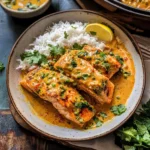
Baked Coconut Curry Salmon Recipe – Easy & Delicious!
- Total Time: 30 minutes
- Yield: 4 servings 1x
Description
Tender, flaky salmon baked in a creamy coconut curry sauce makes this dish both comforting and packed with bold, exotic flavor. It’s an easy one-pan meal that’s perfect for weeknights or impressing guests with minimal effort.
Ingredients
-
4 salmon fillets (about 6 oz each)
-
1 tbsp olive oil
-
1/2 small onion, finely chopped
-
2 cloves garlic, minced
-
1 tbsp fresh ginger, grated
-
1 tbsp red or yellow curry paste
-
1 tsp ground turmeric (optional)
-
1 can (13.5 oz) full-fat coconut milk
-
Salt and pepper, to taste
-
Juice of 1/2 lime
-
Fresh cilantro or basil, for garnish
Instructions
-
Preheat Oven: To 400°F (200°C).
-
Make Sauce: In a skillet, heat oil over medium heat. Sauté onion, garlic, and ginger for 2–3 minutes. Stir in curry paste and turmeric; cook another 1 minute.
-
Add Coconut Milk: Pour in coconut milk and stir. Season with salt and pepper. Simmer for 5 minutes, then stir in lime juice.
-
Bake Salmon: Place salmon in a baking dish. Pour sauce over the top. Bake uncovered for 15–20 minutes, or until salmon flakes easily with a fork.
-
Garnish & Serve: Top with fresh herbs and serve with rice, quinoa, or steamed veggies.
Notes
-
Use skinless salmon for easier serving and better sauce absorption.
-
Curry paste intensity varies—start with 1 tbsp and adjust to taste.
-
Add chopped spinach or bell peppers for extra veggies.
-
Pairs well with jasmine rice or coconut rice for a complete meal.
- Prep Time: 10 minutes
- Cook Time: 20 minutes
Nutrition
- Calories: 420kal
- Sugar: 2g
- Sodium: 320mg
- Fat: 29g
- Saturated Fat: 18g
- Carbohydrates: 5g
- Fiber: 1g
- Protein: 35g
